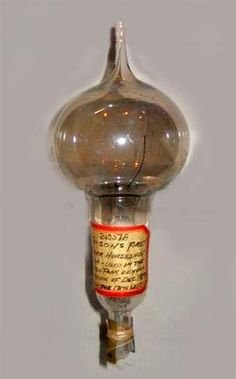Thomas Edison and the “first” light bulb
In 1878, Thomas Edison began serious research into developing a practical incandescent lamp and on October 14, 1878, Edison filed his first patent application for "Improvement In Electric Lights". However, he continued to test several types of material for metal filaments to improve upon his original design and by Nov 4, 1879, he filed another U.S. patent for an electric lamp using "a carbon filament or strip coiled and connected ... to platina contact wires."
Although the patent described several ways of creating the carbon filament including using "cotton and linen thread, wood splints, papers coiled in various ways," it was not until several months after the patent was granted that Edison and his team discovered that a carbonized bamboo filament could last over 1200 hours.
This discovery marked the beginning of commercially manufactured light bulbs and in 1880, Thomas Edison’s company, Edison Electric Light Company began marketing its new product.

Other Notable Dates
• 1906 - The General Electric Company were the first to patent a method of making tungsten filaments for use in incandescent lightbulbs. Edison himself had known tungsten would eventually prove to be the best choice for filaments in incandescent light bulbs, but in his day, the machinery needed to produce the wire in such a fine form was not available.
• 1910 - William David Coolidge of General Electric improved the process of manufacture to make the longest lasting tungsten filaments.
• 1920s - The first frosted lightbulb is produced and adjustable power beam bulbs for car headlamps, and neon lighting.
• 1930s - The thirties saw the invention of little one-time flashbulbs for photography, and the fluorescent tanning lamp.
• 1940s - The first ’soft light’ incandescent bulbs.
• 1950s - Quartz glass and halogen light bulb are produced
• 1980s – New low wattage metal halides are created
• 1990s – Long life bulbs and Compact Fluorescent bulbs make their debut.
The Future of the “First” Light Bulb?
Modern incandescent bulbs are not energy efficient – less than 10% of electrical power supplied to the bulb is converted into visible light. The remaining energy is lost as heat. However these inefficient light bulbs are still widely used today due to many advantages such as:
• wide, low-cost availability
• easy incorporation into electrical systems
• adaptable for small systems
• low voltage operation, such as in battery powered devices
• wide shape and size availability
Unfortunately for the incandescent bulb, legislation in many countries, including the US, has mandated phasing it out for more energy-efficient options such as compact fluorescent lamps and LED lamps. There has been much resistance, however, to these policies owing to the low cost of incandescent bulbs, the instant availability of light and concerns of mercury contamination with CFLs.

Congratulations @hmxi! You have completed the following achievement on Steemit and have been rewarded with new badge(s) :
Click on the badge to view your Board of Honor.
If you no longer want to receive notifications, reply to this comment with the word
STOP